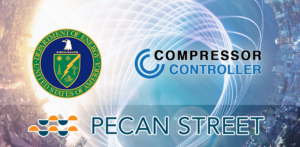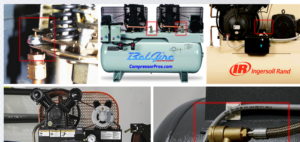Did you know that switching from traditional pressure switches to digital controllers can reduce your compressor’s energy consumption by up to 40%? For facility managers and industrial engineers managing compressed air systems, choosing the right pressure control technology can have a dramatic impact on both operational efficiency and bottom-line costs.
Understanding Pressure Control Basics
Pressure control is the heart of any compressed air system, regulating when compressors turn on and off to maintain desired system pressure. Without proper pressure control, systems can suffer from excessive energy consumption, premature equipment wear, and unstable air pressure that affects production quality.
The primary function of pressure control is to maintain consistent system pressure while minimizing energy consumption. This involves monitoring system pressure and controlling compressor operation to match air demand. System pressure directly affects both energy consumption and compressed air quality – for every 2 PSI increase in system pressure, energy consumption increases by approximately 1%.
Traditional Pressure Switches: The Old Guard
| Feature | Details |
|---|---|
| Initial Cost | $75-200 |
| Installation Time | 1-2 hours |
| Annual Maintenance | $200-400 |
| Pressure Drift | Up to 20% annually |
Air Compressor Pressure Control: Complete Guide to Digital Controllers vs Pressure Switches
Did you know that switching from traditional pressure switches to digital controllers can reduce your compressor’s energy consumption by up to 40%? For facility managers and industrial engineers managing compressed air systems, choosing the right pressure control technology can have a dramatic impact on both operational efficiency and bottom-line costs.
Understanding Pressure Control Basics
Pressure control is the heart of any compressed air system, regulating when compressors turn on and off to maintain desired system pressure. Without proper pressure control, systems can suffer from excessive energy consumption, premature equipment wear, and unstable air pressure that affects production quality.
The primary function of pressure control is to maintain consistent system pressure while minimizing energy consumption. This involves monitoring system pressure and controlling compressor operation to match air demand. System pressure directly affects both energy consumption and compressed air quality – for every 2 PSI increase in system pressure, energy consumption increases by approximately 1%.
Traditional Pressure Switches: The Old Guard
| Feature | Details |
|---|---|
| Initial Cost | $75-200 |
| Installation Time | 1-2 hours |
| Annual Maintenance | $200-400 |
| Pressure Drift | Up to 20% annually |
Traditional mechanical pressure switches have been the industry standard for decades. These devices use a combination of springs and diaphragms to monitor system pressure and control compressor operation. While simple and reliable, they have significant limitations in today’s demanding industrial environments.
Advantages of Traditional Switches
- Simple design and operation
- Low initial cost
- Familiar technology for maintenance staff
- Easy replacement
Disadvantages of Traditional Switches
- Significant pressure drift requiring frequent adjustment
- No performance monitoring capabilities
- Limited control options
- Higher long-term maintenance costs
Digital Controllers: The Modern Solution
| Feature | Details |
|---|---|
| Initial Cost | $800-2,500 |
| Installation Time | 2-3 hours |
| Annual Maintenance | $100-200 |
| Pressure Accuracy | ±0.1% |
| Energy Savings | 20-40% |
Key Features
- Precise digital pressure monitoring
- Real-time temperature tracking
- Automated system diagnostics
- Data logging and analysis
- Multi-compressor coordination
- Remote monitoring capabilities
Direct Technology Comparison
| Aspect | Traditional Switches | Digital Controllers |
|---|---|---|
| Pressure Control | ±5-20% variance | ±0.1% variance |
| Energy Efficiency | Baseline | 20-40% improvement |
| Maintenance Needs | Frequent calibration | Minimal maintenance |
| Lifespan | 3-5 years | 10+ years |
| ROI Period | N/A | 12-18 months |
Real World Applications
Metal Fabrication Facility Case Study
Location: Ohio
- System Size: 5 compressors
- Energy Reduction: 32%
- Annual Savings: $27,500
- Payback Period: 13 months
Implementation Guide
1. System Assessment
- Document current performance metrics
- Identify pressure requirements
- Map existing control infrastructure
- Calculate potential energy savings
2. Controller Selection
- Determine required features
- Consider future expansion needs
- Evaluate communication requirements
- Review compatibility with existing equipment
3. Installation Process
- Professional installation recommended
- Proper sensor placement
- System configuration and testing
- Staff training
Future Trends
The compressed air industry continues to evolve with new technologies emerging regularly. Digital controllers are well-positioned to adapt through software updates and modular design. Key developments include:
- Enhanced IoT integration
- Artificial intelligence optimization
- Predictive maintenance capabilities
- Cloud-based monitoring and control
Making the Right Choice
| Consider Digital Controllers If: | Stay with Traditional Switches If: |
|---|---|
| Multiple compressor system | Single small compressor |
| High energy costs | Limited budget |
| Variable air demand | Constant air demand |
| Need advanced monitoring | Simple operation required |
Take the Next Step
- Conduct a system audit
- Calculate potential energy savings
- Consult with qualified specialists
- Develop an implementation plan
Ready to optimize your compressed air system? Contact a compressed air efficiency expert today to learn how digital controllers can transform your system’s performance and reduce operating costs.



